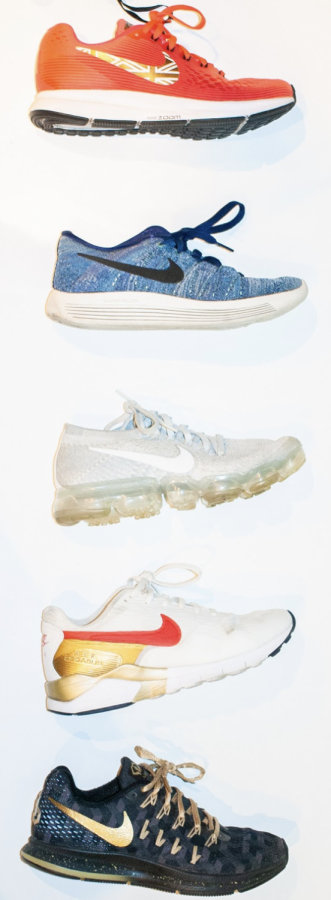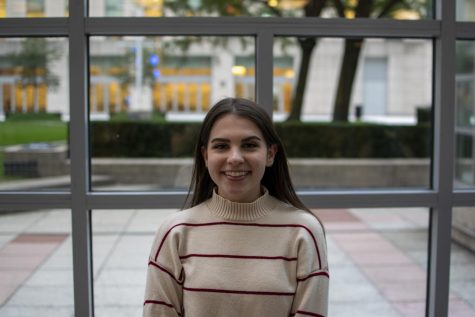The Rundown on Sneakers: Is Your Shoe Right For You?
JOE ROVEGNO/THE OBSERVER
Brands like Nike, Adidas and Brooks carry many different models of shoes made for all kinds of feet.
March 14, 2019
Not all running shoes are created equal and neither are all feet. Pairing the wrong shoe with the wrong type of foot can cause frustrating and painful injuries. If you find yourself dealing with anything from small blisters to serious pain in your feet, ankles, knees and even hips before, after or during your run, it might be time to take a serious look at your shoes.
When picking out a running shoe, it is best to start at a specialty running store. A store like New York Running Company, which has a location near Fordham’s Lincoln Center campus in the Time Warner Center, is the best option because they carry a wide range of brands.
At a store like this, employees are trained to be able to look at your feet and bring out a variety of shoes for you to try based on what they think might work best for your needs.
An employee will start off by making sure you know what size you’re looking for. Making sure you are wearing the right size shoe will eliminate the risk of blisters and rubbing in the wrong places.
Next, you might even take a quick run on a treadmill, so an employee can examine your gait, which is how your foot comes off of and hits the ground when you walk and run.
They will also check to see if you overpronate. Overpronation is when your foot rolls inward as you move forward.
You might even be able to tell if you overpronate on your own by examining an old pair of running shoes. Flip your shoe over and if most of the wear is on the inside of the sole, or if when you place the shoes on a flat surface they tilt inward, you are probably overpronating and are in need of stability shoe and possibly an insole. Both can be picked up at a specialty running store.
The opposite of overpronation, supination, is rarer, but would also require a stability shoe.
Another factor to take into account is if you’re running in New York City, including the parks, your feet are hitting asphalt or concrete. Hard surfaces like these are less forgiving than grass or dirt trails, which means you are going to want a certain level of cushion to your shoe as well as some support for your ankles.
Luckily for New Yorkers, running shoes have never been more comfortable. Nike recently released its second version of the popular lightweight, high-cushion shoe, the Epic React Flyknit. Nike’s hot new sneaker competes with Adidas’s tried and true Ultraboost, one of the first of its kind when it comes to bounce-factor and comfort.
Trendy running shoes like these come at a high price point, but fear not — there are plenty of other shoes out there from Nike, Adidas and beyond that will have you on your way to some pain-free miles in the park.
The Nike Air Zoom Pegasus is a classic, neutral shoe that is a favorite among beginners and professional runners. The 35th version of the shoe was released last year, alongside Pegasus Turbo, the faster version of the shoe, which was designed for elite athletes in Nike’s attempting to break the two-hour mark in the marathon.
The Pegasus is engineered to deliver a smooth stride, but if you’re looking for a little more support in your shoe, you can turn to the Pegasus’s cousin, the Air Zoom Structure. This shoe keeps the same ideas of speed and comfort in mind while bumping up the stability of the shoe to combat overpronation.

From top to bottom: Nike Air Zoom Pegasus 34, Nike LunarEpic Flyknit, Nike Air Vapormax Flyknit, Nike Air Pegasus 92/16, Nike Air Zoom Pegasus 33
Caroline Donahue, Fordham College at Rose Hill ’19, spoke to The Observer last fall as she prepared to run her second New York City Marathon. Donahue trained for and ran the marathon in the Pegasus 35. Having suffered from a few different foot injuries, Donahue found that the Pegasus 35 was the most comfortable and padded for her.
“I made sure that the shoes I wore for the marathon were broken in enough, but not so much so that they had lost a significant amount of support,” she said.
The Asics Gel-Nimbus and Gel-Kayano have a similar relationship to the Nike Pegasus and Structure. The Nimbus is Asics’s basic neutral running shoe, whereas the Kayano comes in with the support.
Another brand with the same idea is Brooks. The Ghost is Brooks’s neutral shoe, followed by the Ravenna, which brings the support. Don’t be afraid to go for the support shoe if that’s what you need.
In the era of cushion, brands are not sacrificing comfort for support. If you really want to find a shoe that does both, turn to Hoka. Hoka is a high-cushion brand with models like the Bondi or the classic Clifton, but they also have support shoes. The Hoka Gaviota and Arahi have the same thick, bouncy soles as their neutral counterparts, but look out for your feet and ankles as well.
Zach Watterson, Gabelli School of Business at Rose Hill ’19, also spoke to The Observer about his preparation for the 2018 New York City Marathon last fall. Watterson favors one of Saucony’s neutral shoes, the Ride, and has been wearing it since he first started taking running seriously before his first New York City Marathon in 2016. He wore the newest version of the Ride at the time, the Ride 10, for last year’s race.
“Picking a running shoe is really just a personal choice, so it’s different for everyone,” Watterson said. “I always train with the same shoes that I run races with. For me, it’s all about finding what is right and comfortable for you and sticking with the same shoe.”














